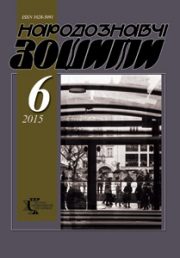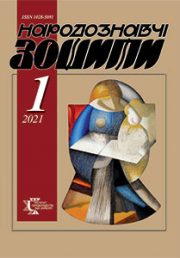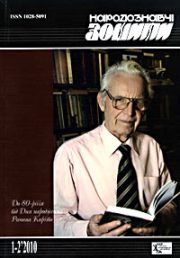The Ethnology Notebooks. 2020. № 3 (153), 558—562
UDK 398.21:[94:323.1](477.82)”19″
DOI https://doi.org/10.15407/nz2020.03.558
CHIKALO Oksana
ORCIDID: https://orcid.org/0000-0002-1636-3397
Candidate of Philology, Senior Researcher
Senior Researcher, Department of Folklore Studies,
Institute of Ethnology, National Academy of Sciences of Ukraine,
15, Svobody Avenue, 79000, Lviv, Ukraine,
Contacts: e-mail:ochikalo@yahoo.com
Abstract. The article analyzes narratives that reflect the prerequisites of the Polish-Ukrainian conflict in Volhynia in the late 1930s and 40s. The specificity of perception and understanding of these events in the national environment is clarified. Features of plot construction based on time-spatial characteristics are investigated. The specificity of broadcasting this prose material in different age groups is considered.
The purpose of the publication is to find out the specifics of perception and understanding of the events of the middle of the last century in Volyn; to analyze how the national environment, depending on the epic position of the narrator, reproduced information about them; to consider features of broadcasting narratives about the state of Ukrainian-Polish relations (especially at the domestic level) in the run-up to the Ukrainian-Polish conflict.
The object of the study is the folk tales of the Volyn tragedy of the late 1930s and early 1940s recorded in the Gorokhiv Region in 2018. They became the basis for studying the background of the Ukrainian-Polish conflict in Volyn and the specifics of their reflection in folklore narratives.
The article synthesizes methods that are subordinated to the purpose of exploration: historical, which makes it possible to study the historical and political processes of the twentieth century; historical and typological, which involves the identification of typological parallels of the studied plots, motifs, images in different genre formations of Ukrainian folklore at synchronous and diachronic levels. This method allows to trace the realization of one or another motive in samples close in content to genres; historical-genetic, by which one can consider the evolution of individual plots and motifs and ways of expressing them in folklore texts; a field research method that allows you to discover newnarratives, find out the features of contemporary living and distribution; interdisciplinary, which allows to involve in the analysis of folklore materials the methodology of different scientific disciplines: history, folklore, ethnography, statistics, etc.
Keywords: Ukrainians, Poles, Volyn, narrative, chronotop, plot, folklore, folk environment.
Received 19.05.2020
REFERENCES
Mishanich, S. (2003). Near the sources of folk prose. Folklore and literary studies (Vol. 1, p. 297). Donetsk [in Ukrainian].
Davidyuk, L. (2017). Narrative discourse of oral non-fairy tales. Science and Education a New Dimension. Philology (Vol. V (39), issue 143). Retrieved from: www.seanewdim.com.
Pushuk, I. (2009). From the compiler. The tragedy of the Ukrainian-Polish confrontation in Volyn 1938—1940. Gorokhiv district (Р. 6). Lutsk [in Ukrainian].
Sergiychuk, V. (2003). Poles in Volhynia during the Second World War. Documents from Ukrainian archives and Polish publication (P. 8). Kyiv [in Ukrainian].







